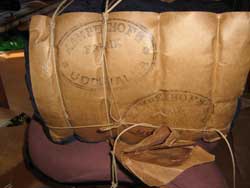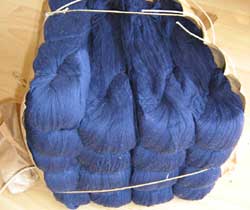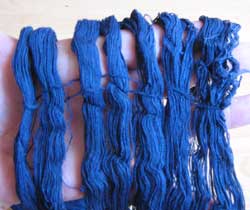To read older weaving literature
Older weaving literature often uses a language that we do not readily understand – or at least do not understand precisely.
This article is concerned with "Praktisk vävbok tillägnad den idoga Svenska kvinnan" by Nina v Engeström (1st ed 1896) – now available in an English translation from Vävstuga in the US, or from the publisher Bokförlaget Rediviva.
About yarn packages and numbers
On page 5 the first somewhat obscure table can be found: (my translation)
" About yarn and reeds
A bundle of cotton yarn no 8 usually contains 8 hanks
[...]
One hank cotton yarn is about 720 meters = 1200 alnar (note 1) and will
suffice for about 12 meters = 20 alnar, 1 lea (note 2) wide. For example, if one is to wind a warp 12
meters 30 leas, bobbin 30 hanks."
The 720 meters give us an idea that the yarn numbering system used in 1896 is the same as is used today, the cotton count (also abbreviated Ne) (note 3).
But how much is a lea? Calculating backwards from the 12-meter warp above, the "lea" will result in 60 ends (720/12 = 60). This figure can also be found in "Ny väfbok II" (see appendix: excerpt in Swedish) – but there it is also said that the number of ends in a "lea" differs between parts of the country.
About reed sizes
On page 6 there is a table of reeds that also looks unfamiliar (my translation):
" Information about the, in ordinary circumstances, used reeds for different counts of cotton yarn:
For number 8 ........ 120 to 130 dents in 15 cemtimeters = 1 qvarter
(note 4)
" "
10 ........ 130 to 140
[...]
" "
26 ........ 200 ........ 2 ends in each dent. "
First, it can be seen that "2 ends in each dent" is probably meant to be applied to the whole table. 120 dents in 15 cm corresponds to 8 dents/cm (or 20 dents/inch). Experience tells that that number is far too low for a hard-wearing fabric – the doubled number would be more appropriate. (Remember that a singles cotton no 8 has approximately the same grist as has a two-ply cotton no 16, also written 16/2.)
Next question what the reed numbers mean, compared to modern reeds. And why are they given in 15 cm = 1 qvarter?
A reasonable explanation, even if only built on guesswork, can be the following:
Before 1878, when the SI system (the decimal system for weights and measures, with kilogram, meter and second as the base units) was, by law, introduced in Sweden, the foot was used as the base length unit. One Swedish foot was 0,2969 meters, and was divided into 12 inches ("verktum"). 1 inch was divided by successive halving: 1/2, 1/4, 1/8, 1/16, 1/32, 1/64 etc. (Note that one imperial foot is 0,3048 meters, so the Swedish inch was slightly shorter.)
Reeds for weaving are traditionally manufactured by wrapping a thread or a cord around the wooden supports, then one spline is inserted, the cord is wrapped, next spline is inserted and so on, until the reed is complete.
Let us assume that the cords used for the distances were made in different (standard) grists, and were defined by their diameter. This would mean that the divisions between dents would come to be – by standard – 1/2, 1/4, 1/8, 1/16, 1/32, 1/64 (and so on) inch. Added to these measurements there were probably used 1/12 and multiples thereof, as 12 is a common base for inch calculations.
As a base for the reed numbers it looks as if the number of dents per half foot, ie the number of dents per 6 inches, was used. This way of giving a measure can be compared to how the measure of nets and woven filters and sieve material in some countries still is given in "mesh" (number of "holes" per inch), instead of the width of each "hole" itself.
Let us see where we get with this reasoning:



